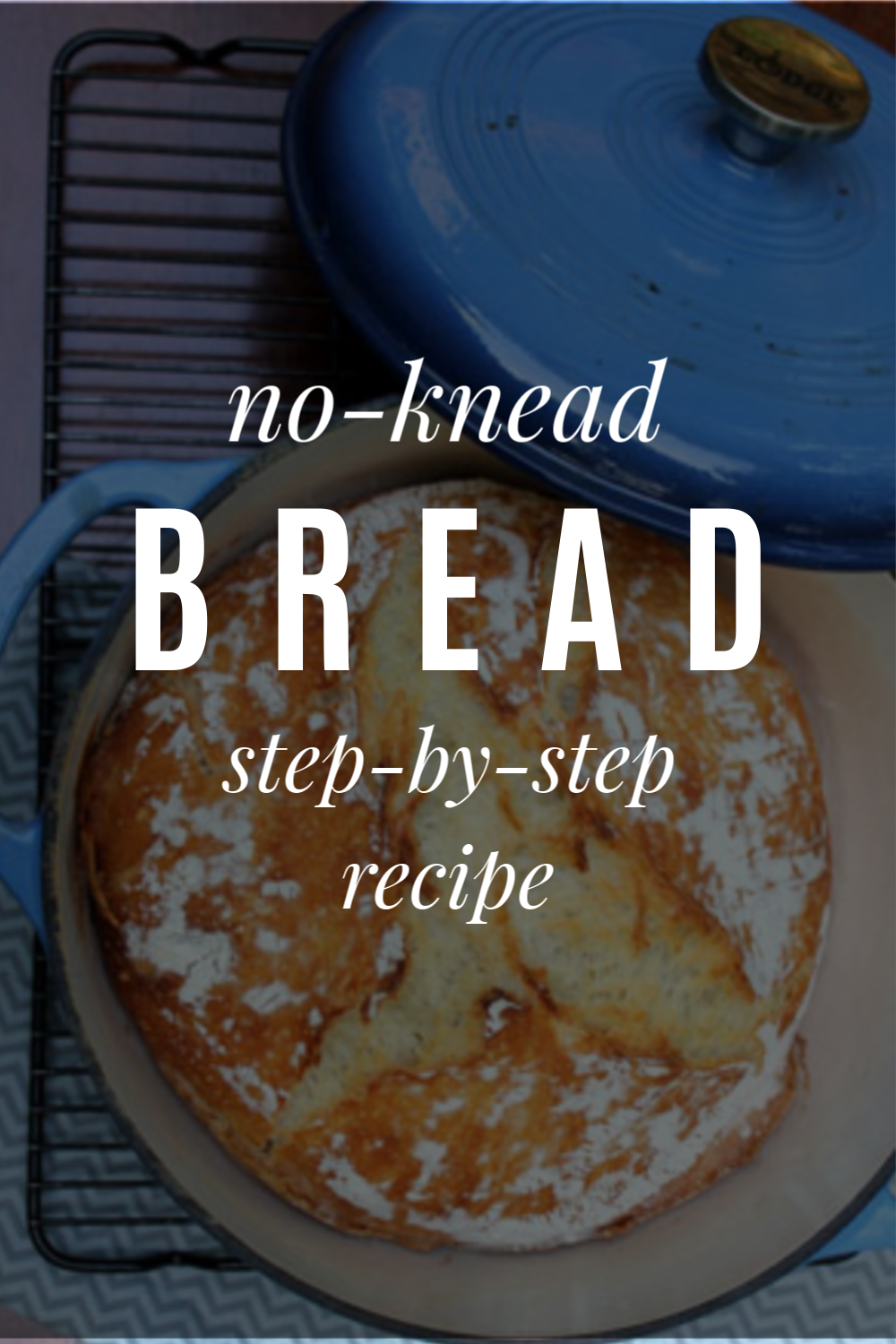
No-Knead Bread Recipe
If you have been hanging out around Frugal Living NW for awhile, you know that I am a big believer in making food from scratch at home. With a few exceptions, I prefer creating something in my own kitchen to buying it in the grocery store.
Bread can be tricky, though. There is some stiff competition out there, and it is tough to replicate a commercial oven’s heat and steam in a normal home kitchen.
For the last several years, I thought that Artisan Bread in 5 Minutes was the best thing since, well, sliced bread. It was simple, and we were content with the results. That is, until last summer when our neighbor brought over a beautiful, delicious loaf of home-baked bread. We had to know her secret. One phone call, and she came back with the book, My Bread by Jim Lahey (Amazon).
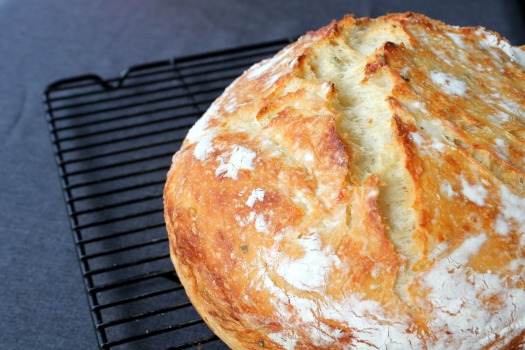
We have been baking bread using this method ever since. I can count on one hand the number of times I have bought bread in the store since then, because I can now make an artisan-quality loaf at home for a fraction of the cost.
I am telling you, this is consistently the best bread I have ever made in my kitchen. Okay, enough gushing. Let’s make some bread.
The only changes I have made to Lahey’s method is to double the amounts and adjust the baking time and temperature to achieve a bigger loaf with a thinner crust.
Oh, and don’t be put off by all these steps. This is totally possible for home bakers at any skill level. I wanted to give you the confidence to do this on your own. A concise recipe can be found at the bottom of this post.
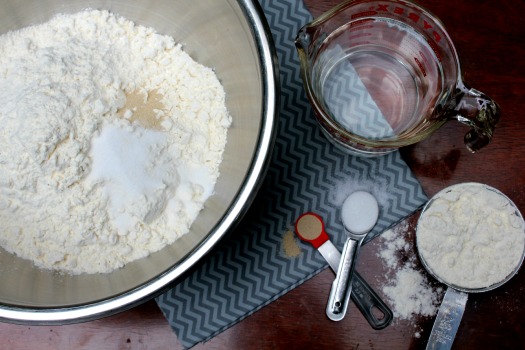
The ingredients are simple: flour, water, salt, and yeast. My husband calculated this bread costs 74¢ per loaf (using Bob’s Red Mill flour & Costco yeast).
Oh, wait! Don’t forget to factor in the roughly 8 cents of energy used to bake it for an hour. No, I’m serious. My husband really does think about this stuff! He’s funny.
So, there you go. A whopping 81¢ for a substantial 2.5 pound loaf of bread. That is crazy cheap.
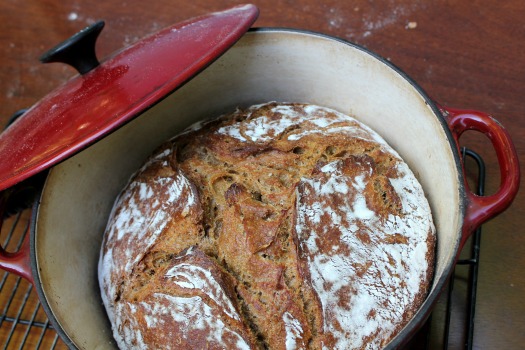
If you want to use some whole wheat flour, substitute 3 cups of whole wheat for 3 cups of the all-purpose flour (3 cups whole wheat and 3 cups of unbleached flour for a total of 6 cups) and add 3 Tablespoons of molasses (optional). This will produce a slightly sweeter, denser loaf of bread. Delicious.
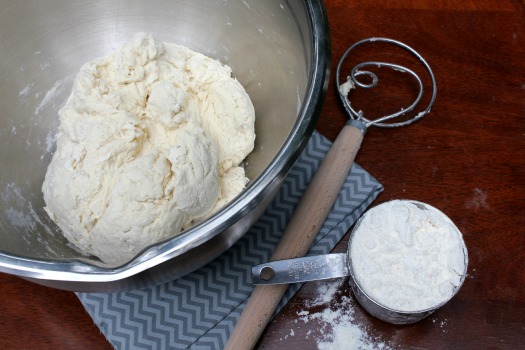
Combine the dry ingredients, add the water, and stir to combine (the funky looking wood-handled item is the amazing Danish Dough Wisk — makes stirring stiff dough a snap). The dough should be wet and sticky. Depending on the temperature and humidity in your home, you may need to add a little more flour or water, 1 Tablespoon at a time. So far, these steps are exactly the same as the 5 Minute method.
The main differences are that you use significantly less yeast (1/2 teaspoon vs. 1 1/2 Tablespoons) and significantly more initial rise time (12-18 hours vs. 2 hours).
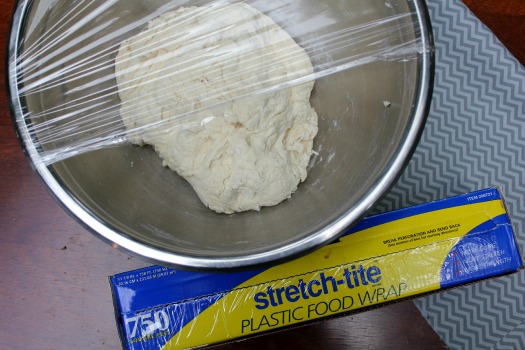
Once the ingredients are completely combined, cover the bowl with plastic wrap and leave it on the counter to rise for 12-18 hours. This slow rise aids in the fermentation of the yeast, giving the bread a better flavor.
Okay, I know what some of you are thinking: 12-18 hours! That’s ridiculous! Who has that kind of time?! I get it.
However, here are two things to consider:
- Once you get into a rhythm of baking your own bread, it’s not a big deal. I start mine in the afternoon or evening and bake it the next morning or afternoon. This would also be an easy weekend routine.
- Just like the title claims, this bread requires no kneading. It is not fussy, temperamental dough. You can produce a delicious loaf of bread with very little hands-on effort & experience.
You’ll know your dough is ready when it has risen in the bowl, smells yeasty, darkened slightly, and is covered with small bubbles.
Using well floured hands, shape and tuck the sticky dough into a rough ball. You can also fold it over a couple times on a well-floured surface. It doesn’t have to be perfect; just keep quickly tucking the dough underneath with your fingertips until you have a semi-smooth dough ball. The dough should be wet but manageable; you don’t want a wet blob so sticky that you can’t shape it into a ball.
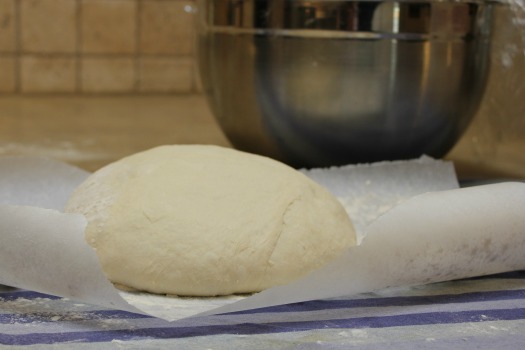
Take a clean linen or cotton tea towel (not terry cloth) and dust it with flour, cornmeal, or wheat germ to prevent the dough from sticking to the towel as it rises. You can also use a floured square of parchment paper on the towel to make the dough ball easier to handle. Place the dough ball, seam side down, in the middle and dust with more flour.
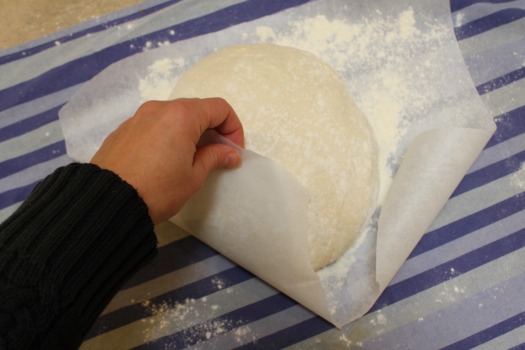
Cover the dough with the (parchment paper and) towel and let it rise for 1-2 hours at room temperature, until doubled in size. During the last 30 minutes of rise time, place a heavy lidded 6-8 quart pot, like a Dutch oven, in a cold oven and preheat it to 425 degrees.
Confession: I own three Dutch Ovens. I use them all the time. They are incredibly versatile and worth the investment. If you don’t own one, you could also make this in any lidded pot, provided it is oven-safe at such high temperatures. Also, check the knob on your pot. If it isn’t rated for such high heat, you’ll want to remove it or cover it with foil. You can also buy an inexpensive replacement knob that is rated for higher temps!
Okay, this is the trickiest part of the entire operation. Remove the lid from the piping hot Dutch Oven, slide your hand underneath the towel or parchment paper, and flip the risen dough (seam side up now) into the pot. Try to flip close to the pot or the flour will fly everywhere. Remove the towel or paper and set aside.
This might take a bit of practice, but again it doesn’t have to be perfect. Some of my worst flips have produced my most beautiful loaves. I love what Lahey writes, “…even the loaves that aren’t what you’d regard as perfect are way better than fine.”
Place the lid back on top and slide the pot back into the hot oven.
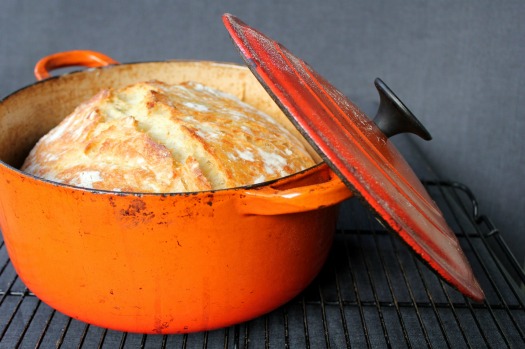
Bake it for 40-50 minutes. Remove the lid. Bake for another 5-10 minutes, until golden chestnut brown. The internal temperature should be around 200 degrees. You can check this with a meat thermometer if you’re nervous about knowing when your loaf is done.
Oh man, your house will smell so good about right now.
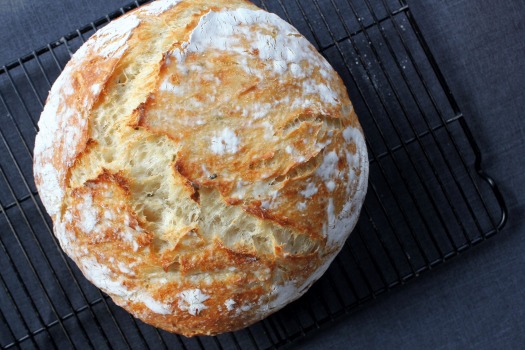
Place the loaf on a cooling rack. You will hear it crackling as it cools. Use every ounce of self-control to resist cutting into it until it is “quiet”; cutting it too soon will make the bread dense and gummy.
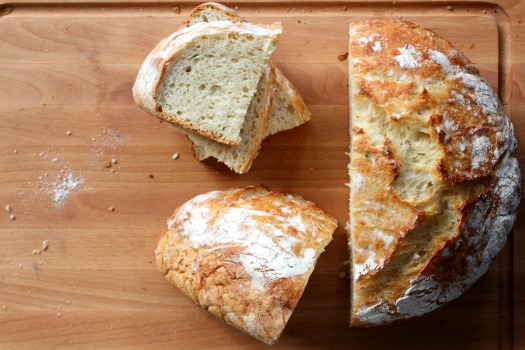
This bread is best the first 2-3 days. I just store my leftover loaf inside the Dutch oven on the countertop. Using plastic wrap will soften the crust. Dry, leftover bread makes great bread crumbs, toast, French toast, or croutons!
Enjoy. And pat yourself on the back. You just baked an amazing loaf of bread!
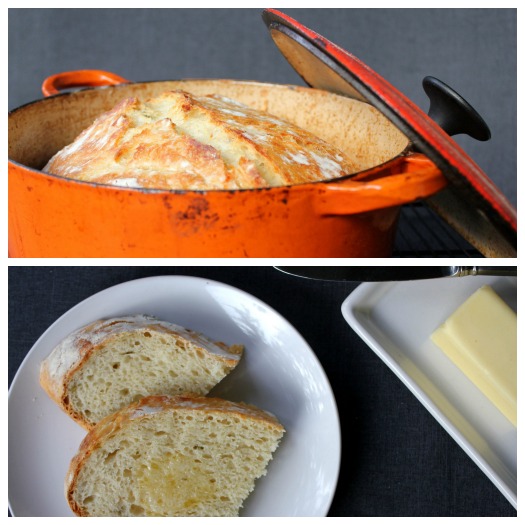
Basic No-Knead Bread
Slightly adapted from Jim Lahey’s My Bread
Ingredients
6 cups bread flour (recommended) or all-purpose flour, plus more for work surface
1/2 t. instant or active-dry yeast
2 1/2 t. salt
2 2/3 c. cool water
- In a large bowl, combine the flour, yeast, and salt. Add the water and stir until all the ingredients are well incorporated; the dough should be wet and sticky. Cover the bowl with plastic wrap. Let the dough rest 12-18 hours on the counter at room temperature. When surface of the risen dough has darkened slightly, smells yeasty, and is dotted with bubbles, it is ready.
- Lightly flour your hands and a work surface. Place dough on work surface and sprinkle with more flour. Fold the dough over on itself once or twice and, using floured fingers, tuck the dough underneath to form a rough ball.
- Place a full sheet/large rectangle of parchment paper on a cotton towel and dust it with enough flour, cornmeal, or wheat bran to prevent the dough from sticking to the parchment paper as it rises; place dough seam side down on the parchment paper and dust with more flour, cornmeal, or wheat bran. Pull the corners of parchment paper around the loaf, wrapping it completely. Do the same with the towel. Let rise for about 2 hours, until it has doubled in size.
- After about 1 1/2 hours, preheat oven to 425 degrees. Place a 6-8 quart heavy covered pot, such as a cast-iron Dutch oven, in the oven as it heats. When the dough has fully risen, carefully remove pot from oven. Unwrap the towel and parchment paper from around the dough and slide your hand under the bottom of the dough ball; flip the dough over into pot, seam side up. Pull the parchment paper off, scraping any stuck dough into the pan. Shake pan once or twice if dough looks unevenly distributed; it will straighten out as it bakes.
- Cover and bake for 40 minutes. Uncover and continue baking for 10-15 more minutes, until the crust is a deep chestnut brown. The internal temperature of the bread should be around 200 degrees. You can check this with a meat thermometer, if desired.
- Remove the bread from the pot and let it cool completely on a wire rack before slicing.
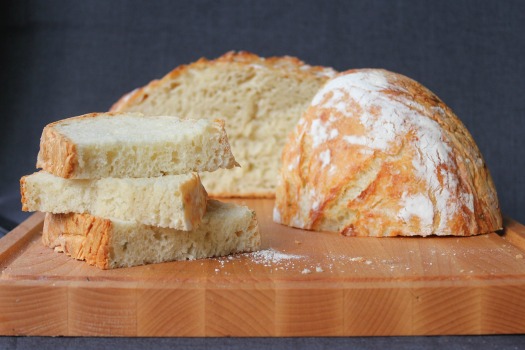
Here are a couple options for Dutch Ovens. Any heavy, lidded 5-8 quart pot (seasoned cast iron or enamel coated) would work with this recipe. Lodge has the best prices/options for dutch ovens on Amazon.
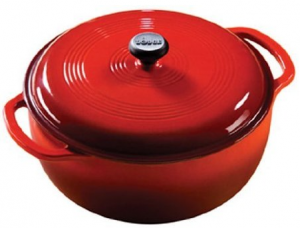
Lodge Logic Dutch Oven in Island Spice Red (6 Quart)
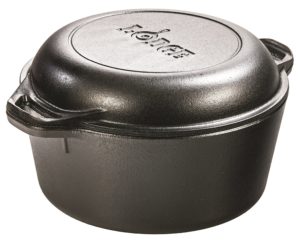
Lodge Cast Iron Double Dutch Oven (5 Quart)
If you already have a dutch oven (or find a deal on a lesser-known brand) that doesn’t have a knob rated for high temps, replace it! There are some really affordable options.
Got questions? You are in good company. Go here for the complete FAQ list.
Looking for more variations to the no-knead bread recipe? We’ve created a list with sweet and savory varieties, including the following:
- Cranberry Orange
- Four Cheese
- Sandwich Bread
- Dark Chocolate Coconut
- Tomato Basil Cheese
- Whole Wheat
Looking for more delicious bread recipes?
Find more delicious recipes on our Recipe Page!
Follow Frugal Living NW on Pinterest!
Fantastic range of boards from best recipes and tips for frugal living to gardening and budgeting help.
This post may contain affiliate links. See the disclosure policy for more information.
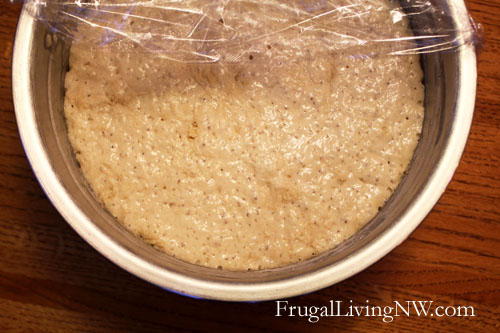
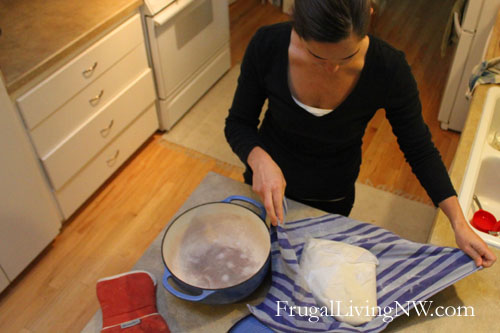
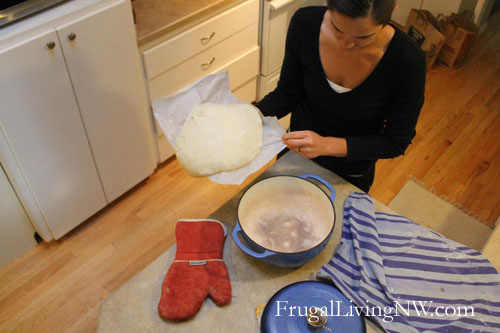

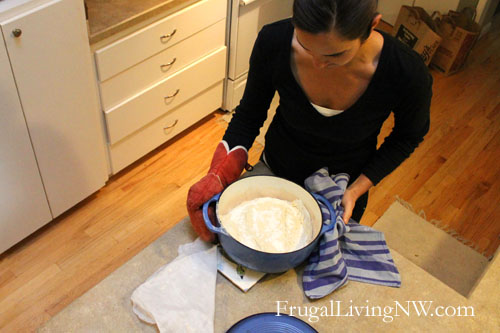
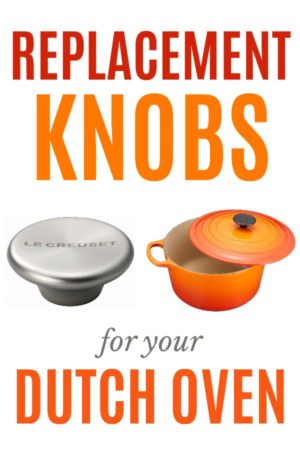

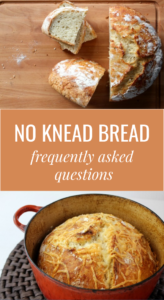
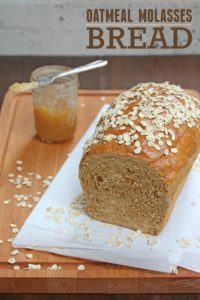
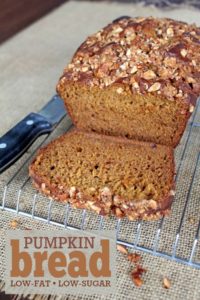
I have been baking from the 5-minute cookbook for about 9 months to rave reviews so am anxious to try this one. I know the recipe I am using requires a non-stick loaf pan which is then heavily oiled. Is the cured cast iron so impervious to sticking that no oil is needed? I have never found mine to be quite that good.
Hi, Jann! If you are nervous about the dough sticking, feel free to add a small amount of oil to the hot pot. Just rub it around quickly with a paper towel before flipping the bread in. I have rarely had issues with sticking, but if my dough is really wet, sometimes I use oil in the pot just in case.
Thanks – am anxious to try (as soon as the current 5-minute Artisanal loaf is eaten.)
I find that if I don’t heat the Dutch oven (cast iron with no enamel) a full 30 minutes before throwing the dough from the above recipe in, then I have problems with sticking. But if I heat it correctly, the bread easily flips out without any greasing.
I use this same method for my gluten-free breads and it works beautifully every single time. Crusty on the outside, soft and pillowy on the inside. Your bread looks sensational!
What recipe do you use for the gluten free? Quite a few questions regarding this………….. Thanks!
I would also like any info on using this method with GF bread
I haven’t personally tried it, but here’s a GF recipe using this baking method: http://glutenfreegirl.com/i-am-stubborn-i-dont-give-up/
Thank you Emily! I will try this!
I found in the FAQs that some readers have tried some additions (cinnamon and raisins for instance), but it doesn’t say when to add them. Do you just add them when you first mix the dough? Thanks!
Jennifer, here are two previous comments to answer your question. Hope that helps!
From Gaille: I always add to the dry ingredients before adding the water to make the dough. Comes out perfect!
From Heather: I made this recipe, but I added two bunches of rosemary and 1 1/2 heads of garlic in with the flour and yeast. I didn’t pre-roast the garlic and the recipe turned out amazing.
I received my first dutch oven for Christmas and have had this recipe of yours bookmarked for a long time. It’s the first thing I made in it and it came out PERFECTLY! MY husband raved and raved and raved about my first dutch oven loaf of bread and I plan on experimenting with different flavors and sizes of bread using this recipe this upcoming week. Thanks for sharing!
-newly minted, happy bread baker
This is my 2nd time doing this bread and I love it. It is so easy . Thanks.
Just finished patting myself on the back after baking my second loaf in 48 hours! My father is the bread baker in the family and with the family in town for the holidays, well, we definitely had some bonding to do. I will be experimenting with different flavors soon. I followed the recipe exactly as stated. I used Fleischman’s Active Dry Yeast, NOT the Highly Active Yeast they make. I guess Ill be giving my Papi a run for his money 🙂
Here is a website that has a comparison of yeast. RapidRise and instant yeast are the same thing. The bags of yeast that I get at Sam’s Club are labeled “instant”. I think both would work. You should open the packets and use just a 1/2 teaspoon. If you can find a jar, it’s much easier to use. Keep it in the freezer and it will last forever!http://www.breadworld.com/rr_vs_ady.aspx
Here is a website that has a comparison of yeast. RapidRise and instant yeast are the same thing. The bags of yeast that I get at Sam’s Club are labeled “instant”. I think both would work. You should open the packets and use just a 1/2 teaspoon. If you can find a jar, it’s much easier to use. Keep it in the freezer and it will last forever!
I’m no bread baker, that’s for sure, so when I saw this recipe it sounded like something even I could do. The first batch came out great, but like someone else said, it was REALLY sticky! The second batch was pretty much the same except it was even wetter and stickier than the first, and didn’t rise as much. It still was a huge hit and had great flavor.
One thing that has me confused is the yeast. The only thing available around here in my rural Kansas town is Fleischmann’s RapidRise Highly active Yeast packets, 1/4 oz in each. Now, on the back it says: “1 envelope dry yeast (1/4 oz) = 2-1/4 teaspoons = 1 cake fresh yeast (0.6 oz)” To me, that is saying that this packet contains 2 – 1/4 teaspoons, or 1/2 tsp, of yeast. But, it is clearly more than 1/2 teaspoon in the packet. So, because I was confused, I have been using a whole packet. Am I assuming wrong? Should I be using the 1/2 teaspoon instead and just seal up the rest in a baggie?
Thanks for taking the time to post this and even more, answer all of our questions 🙂
A packet of yeast contains 2 and a 1/4 teaspoons. A lot of recipes call for a packet of yeast but if one calls for less, than you will need to measure out the amount you need and save the rest.
Thanks so much for this recipe. I went out and bought a dutch oven just so I could make this bread. It is just done baking- it looks beautiful and the house smells amazing. Can’t wait to take it for our friends’ dinner party tonight and try it!!
The bread was fantastic! I already made another loaf for us to have here at home and have dough on the counter for another loaf I will bake tomorrow to take to a New Year’s Eve party. Thank you!
Can’t wait to try some other variations!
Do you have any suggestions on how to make a “flavored” bread using this method? I would love to make the garlic bread I’ve bought at Fred Meyer that has the full-sized cloves of garlic in it. I’ve never made bread before but this method looks like something I could handle!
Hi, Claraboo – I love that kind of garlic bread! And yes, lots of readers have tried different add-ins, from sweet to savory. Check out the comments or FAQ’s for more details! If you want to roast the garlic first, here are the directions for that: http://www.frugallivingnw.com/frugal-homemaking/how-to-roast-garlic-3-easy-steps/
Try the website Simply So Good. She posted this recipe a while ago and has offerred about 30 different flavor pairings she has made at the bottom of the post.
http://www.simplysogood.com/2010/03/crusty-bread.html
Thank you so much this bread was amazing, we all loved it!
Cooked my first batch this afternoon and I already have a second batch rising.
To all others, heed the 70f warning, our house dips to 60f at night and only ever gets to 68f max… Had to leave first batch in furnace room to get it to rise. Took 24hrs.
Second batch is rising in the oven with the oven light turn on for warmth.
Have you tried it with rye flour?
Hi, Ann! I haven’t personally used rye flour for this bread, but someone else left a comment that they had tried it with great success. Here’s what they did: use a 1:2 ratio. (1 c. of rye for every 2 c. of regular flour). Optional: add 1 T. caraway seeds
I’m sorry for what might sound like a ridiculous question, but I’ve never baked before. Does t = teaspoon or tablespoon in your recipe?
Good question, Angie!
t = teaspoon
T = Tablespoon
This recipe is a great place to start. Let us know how your bread turns out!
I have just made batch #2 with this awesome recipe! Instead of a Dutch oven, I used two standard loaf pans, buttered. I let the dough raise in the loaf pans (for Step 3) and baked for 25 minutes, uncovered. Perfection! The loaves will be a bit flat on top, not rounded like regular kneaded bread, but the taste and texture are amazing!
I asked for a dutch oven for Christmas and made this bread for the first other day. AMAZING! The only problem was that it started drying out before we could eat it all. If I split the loaf could half be frozen to bake later?
It would probably just be easier to cut the recipe in half if you have a hard time eating it before it starts to dry out (Cut all ingredients in half and bake at 425 for 30 min. covered, 8-10 uncovered). The bread is generally soft on days 1-3. After that it starts to dry out. If you have leftovers, it works great as French toast, toast, grilled cheese sandwiches, breadcrumbs, croutons, etc.
My family was extremely pleased when I finally gave the ok to try the bread. There wasn’t much left for dinner! I borrowed a neighbor’s Lodge pot and now I really need to get one of my own since this is my new favorite bread. If you buy the large bags of yeast at a wholesale club, they will forever (at least 18 months past the use by date!) if you keep it in the freezer. Sometimes I get lucky and find bread flour at Sam’s Club at a good price. Thank you!
I am so glad that I found your recipe. I love to bake bread on the weekends for my family and experiment with different recipes. This is the easiest bread I have ever made. I used a pampered chef pot to bake the bread…it is perfect. My mother owns several dutch ovens and she bakes bread all the time the conventional way. I can’t wait to share this with her. Thank you.
Took it out of the oven about and hour ago. Came out wonderful. Looks exactly like the loaves above. Has a great crust and nice airy inside. So easy — will make many more. Thanks
This is a great recipe for crusty Artisan bread. I have tried many bread recipes & it always comes out tasteless! I omitted the plate and just added a little more flour & turned it several times on the parchment paper. I then flopped it into my ungreased Dutch oven. I will be making this again with garlic, onions, rosemary, & black pepper seasoning. Thank you!
Try reading all the comments before asking questions! I read thru them all so that I could make sure I wasn’t repeating myself. Emily has done an amazing job answering them! Also you can check to have the comments come to your email so that you can read the suggestions and comments for new ideas!
Hi Emily – I use almond-flour (am gluten-intolerant, and am experimenting with flour options). Can I substitute almond or even potato flour with the ordinary flour used in this recipe?
My second loaf and I did it w half wheat flour. Amazing! I am wondering if I can form small rolls and cook them the same way in the dutch oven or will handling the dough ruin it.
I’m making this bread now, my uncle sent me almost the same recipe but its just half the recipe and the temp is 450 for 30 mins & 10 mins w/lid off, I let it rise 21 hours, it didn’t seem to rise like I expected but it bubbled and it double from original size. I only have a 5 quart oval Dutch oven. Has anyone used an oval one before? Also mine didn’t really shape into a ball but spread out on the parchment a little but it’s in the oven now so we shall see! I’m so excited to taste it and I only hope it looks half as gorgeous as yours 🙂 next time ill double the recipe
I actually think an oval one would make it more sandwich friendly than round. Good luck!
Dumb question I know but, do I need to sift the flour? I’m asking for a Dutch oven for Christmas. :0). Looking forward to trying this.
Hi, Cindy! No need to sift the flour!
How many servings does this make? I’m thinking of making individual loaves (somehow!) for bread bowls.
Hi, Rebekah! This recipe will give you a large 2.5 pound loaf. I would say 24-30 half slices (12-15 large slices) of bread? Trying bread bowls is next on my list, too!
What would happen if i use self rising flour? That is all i have right now.
We keep our home very cool (62-65) will the dough rise okay?
I came across this post on Pinterest. My 4 year old and I assembled the ingredients this evening. My dough wasn’t wet though- very sticky but not wet. I added about 1/4 cup more water, is that a bad thing? Also, I noticed there isn’t any fat in the bread, but all my other recipes include EVOO or butter (oh! and sugar!)- what gives? And finally, I just want to be sure- the recipe you posted is your double recipe right? There was so much of it, I had to switch to a bigger mixing bowl midway. I am a little worried I won’t be able to bake it all in my dutch oven, can I cut it to make two loaves? Thanks so much!
Hi, Leila! Glad you are trying this recipe.
The dough will turn out a bit differently for everyone depending on the temperature and/or humidity in your home. How you measure ingredients can also make a difference. Sometimes I need to add extra water, sometimes I don’t. Your wet dough should be just fine! If it is too wet to handle after that initial 12-18 hour rise, just add a little flour, 1 Tablespoon at a time, until you can quickly form it into a rough ball with your hands.
There’s no fat in this recipe. Adding butter or oil makes a bread softer/more tender. This bread has a soft, chewy interior but it dries out faster than your typical sandwich bread or rolls.
No sugar either. I have added molasses or honey with great results. I know others have added a little sugar for bigger air holes in their bread. I like it just fine without (traditional baguette/rustic bread: just flour, water, yeast, and salt).
And finally, this does make a large loaf. A 5-7 quart Dutch oven works great. If yours is smaller, you could split it into two loaves when you shape the dough for the second rise. You can bake them at the same time if you have two pots.
Hope that helps!
Thank you so much!
Eeek! It worked!! Its so pretty!! Thanks again!
And we tasted it! Awesome. I think you are my new favorite person.
Pretty sure THIS is one of my biggest accomplishments in life…being able to make my own bread 🙂 Thank you so much for sharing.
Found this on pinterest and made it today! AMAZZZZING!! It’s SOOO beautiful and tastes great! Thanks so much for sharing!
When do I add cheese and herbs?? I can hardly wait to make this bread!!
has anyone had success with gluten free flour?
This to a lot longer on the initial rise, but it was beautiful and tasted good too!
I am totally miffed by this recipe. i will never bake any other bread, ever! Coolest thing ever and i have been cooking professionally for 30 yrs.
I didn’t pay attention to the time given for the dough to sit. Can I go over the 12 to 18 hours?
Hi, Jude – Yes, you can go over 18 hours and it shouldn’t be a problem, especially if your house is cooler. The dough is very forgiving. Someone left a comment pushing 24 hours and said the bread still turned out great. It might impact the flavor a bit. Let us know!
Thanks!
My house is really chilly-my kitchen rarely gets over 65. Would this affect the rising part? Let it rise longer? Sometimes it’s 60 at night. Would that be too cold for this bread to rise properly?
Hi, Chris –
You should be fine! Just don’t get stuck on times too much. Pay attention to the signs that it has risen enough. You will probably be at the higher end of the rise time, 18+ hours. Let us know how it turns out!
Can you share what changes you had to make when you doubled the recipe? Thanks!
I just doubled the ingredients, decreased the baking temp, and increased the baking time. Check out Jim Lahey’s book, My Bread, for the original recipe (it’s all over the web, as well).
can this be made without any salt or less salt?
Sure! Check out the FAQ’s for some salt alternatives. Some have omitted it altogether and added herbs for flavor instead. Up to you!
I just made this bread (the wheat and molasses version) and it came out sooooo good. I did a different no knead recipe a few days ago that wasn’t as good. This loaf was so good-looking and delicious! I had been making loaf bread before having my 2nd child in Jan this year, and am finally getting back into it. Excited to experiment with smaller loaves and flavors. Thank you!
This bread was easy to make. . .even in the midst of 4 children running around, a one hour errand that turned into 2, dogs barking, telephone ringing. . .you get the idea! What thrills me is that it is no fuss AND I don’t have to worry about keeping the dough warmer than room-temp. Now, I’m just waiting on it to cool so I can have that first slice! Thanks!
It may be just a tad hyperbole to say this bread is life-altering….in a good way! I have to express my gratitude for sharing this wonderful recipe on your blog. I’ve tried making no-knead bread in the past and failed miserably those 3 times. Your picture of the risen, bubbly, darkened dough was invaluable.
But I do have one confession to make. I added one tbsp of sugar, and increased the years to 1 tsp (just because that’s what was left in the package!). The bread tastes just like my favorite bread from a local bakery. I feel like I just learned the best secret around!
So thanks again to you, and thanks to Pinterest for helping me find you!
Have you had any experience making this with Bob Red mills gluten free flour?? Wondering if I need to alter the recipe in any way!
Hi, Kiwe! I have looked and heard from a few people who have tried GF variations/flours. So far, no one has been thrilled with the results. I would love to hear if anyone has had success making this GF! Sorry I’m not much help in this department. Maybe I need to start experimenting? Let us know if the Bob’s works for you!